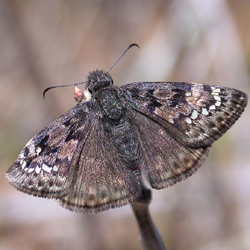Butterfly Atlas
Find a Butterfly
Juvenal's Duskywing
Erynnis juvenalis

Identification
Wingspan 1 1/4 - 1 3/4" . This is our commonest and most widespread duskywing and is relatively easy to identify. As such, it is useful as a basis of comparison with the other species. Its relatively large size alone is a very reliable field mark, and will distinguish Juvenal‘s from all other duskywings except Horace‘s. Another excellent mark is the presence of two prominent tan spots near the outer edge of the hindwing below, which are unique to this species. As far as known, these spots are never completely missing in Northeastern populations, though they may be reduced or obscure in a few individuals. From above the males are nearly indistinguishable from Horace‘s, and the females slightly less "contrasty".
Distribution
Throughout the United States and southern Canada east of the Great Plains from southeastern Saskatchewan to Nova Scotia, south to Texas and Florida. There are also isolated populations in the Plains and a southwestern population that ranges south to southern Mexico. Throughout southern New England, becoming more local northward.
Status in Massachusetts
Common to abundant throughout the state and probably resident in every town, though Atlas records are spotty in the Berkshires and northern Worcester County. Maximum: 50 at Martha‘s Vineyard (Dukes Co.), 14 May 1988.

Flight Period in Massachusetts
Late April to early June, peaking in mid- to late May. Occasionally a very small "false brood" in July and August (See Life Cycle, below). Extreme dates: 23 April, 1988, Milford (Worcester Co.), R. Hildreth 28 April 1986, Sudbury (Middlesex Co.), R. Walton; 26 June 1988, Otis (Berkshire Co.), E. Dunbar; 29 June 1987, Brookfield (Worcester Co.), L. Lovell. A single record from the "false brood" during the Atlas period: 7 July 1986, Uxbridge (Worcester Co.), R. Hildreth.
Larval Food Plants
Oaks of several species. In Massachusetts, Schweitzer (pers comm.) has recorded it on Red Oak (Quercus rubra - UMass Amherst campus), and White Oak (Q. alba - Middlesex Fells). It is also known to feed on Black Oak (Q. velutina), Scrub Oak (Q. ilicifolia), Chestnut Oak (Q. prinus) and Post Oak (Q. stellata), all of which occur in Massachusetts. Scott (1986) notes that it "probably" feeds on American Beech (Fagus grandifolia) in Nova Scotia.
Adult Food sources
Recorded from 16 species of wildflowers during the Atlas period including several heaths, violets, composites and members of the rose family. As with other duskywings, males sip from moist ground; they also visit mammalian feces.

Habitat
Oak woods, pine barrens, concentrations of oaks in mixed hardwood forests. Often seen on paths and in utility corridors, as well as in the interior of the woods, but seldom strays out of its habitat.
Life Cycle
One brood. While Scudder (1889) refers to "a much less numerous" second brood and a single late July specimen was collected during the Atlas (See above), summer individuals in fact represent a very rare "false brood". Shapiro (1966) also reports a few of these near Philadelphia, but Burns (1964) had no such records. EGG: "Pale pea green, becoming salmon red in two days" (Scudder, 1889). A hemispherical dome with 16 vertical ribs with finer raised horizontal lines between the ribbing. OVIPOSITION: Eggs are laid singly on the underside of leaves, from mid-May to mid-June, hatching in about eight days. LARVA: Stout and tapering to both ends, pale to dark green, covered densely with tiny yellowish points, giving a yellow cast and "mealy" texture overall; each point with a single short grayish hair. There is no dark line down the back, but a single pale yellow line along the sides. The head is pale greenish gray to tan with variable salmon orange spotting. The caterpillar makes a folded leaf nest as a daytime retreat as is typical of the duskywings (See under Columbine Dusky Wing for a detailed description). It matures in July, aestivates during the summer, then constructs a silk-lined closed leaf nest in which to hibernate. At least some larvae remain on the tree through the summer and then drop in their nest to the ground in autumn. CHRYSALIS: Grayish, tan or reddish brown, the abdomen "tinged with salmon" and the wings greenish brown; covered thinly with short, pale hairs. PUPAL STAGE: The mature larva emerges from its hibernaculum in late March or early April and makes a new leaf nest in which to pupate without further feeding. Duration: about a month. OVERWINTERING STAGE: Full grown larva.
The adults are very active and pugnacious. Males are highly territorial, with at least one favorite perch consisting of a projecting branch or occasionally a dead plant stem, usually about 1 to 3 feet off the ground.
Account Author
Chris Leahy



